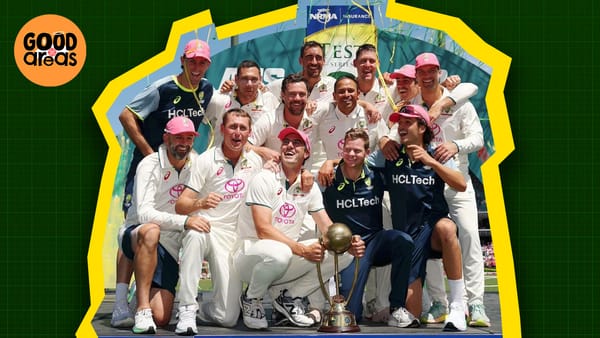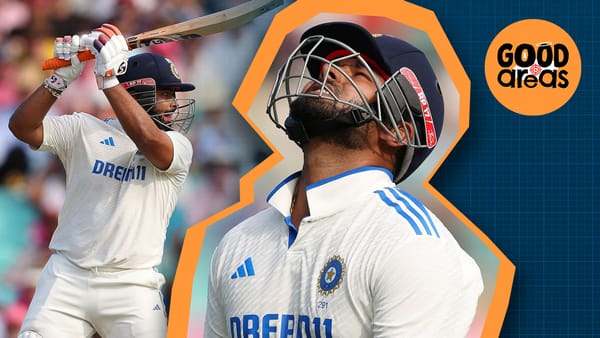How two new balls changed ODI cricket
In October 2011, cricket changed how many new balls it uses in ODI cricket. So we looked into what actually changed.
We use two new balls in ODI cricket now, and that makes people angry. But we actually used two balls in 50 over cricket always. Because leather won’t dye white correctly as it does with red, the balls are lighter in colour for their natural state. But to make them bright white they have their colour sprayed on.
White balls start harder and swing more than red ones, and after five or so overs are softer and stop swinging. Then as they degrade quicker, they pick up dirt and grass as well. So they stop doing anything at all, you can’t see them, or hit them as far. They are simply not fit for purpose.
Before what would happen is that at one stage in an ODI, the umpires would look at the sad, grey piece of sponge and decide to replace it. Later on they just unofficially changed it around the 35/36 over mark with a ball that was used, but not abused.
So at the end of 2011, the ICC made a decision that still annoys many ODI fans. They abandoned the one new ball and one soiled ball strategy and went with two new balls. Which they had done before.
Politically this looked bad, as India had just won a World Cup, and it was seen that the Asian teams who relied on spinners were being punished.
What if I told you that they were not? In fact, it even got worse for pace bowlers after the change as well.
So we looked at what happened in ODIs for the four years before the change, and then the four years afterwards for all bowlers, there are just more runs made. Now, there would have been anyway, runs have been increasing for decades with or without two new balls.

This is the runs per over in ODI cricket. In 2003 it was 4.54, and this year it’s 5.3, but you can see that in between it has grown. You will notice that I am not showing the year here, and there is a reason for that, I’d like you to make a guess when based on this the two new balls were taken.

Chances are you picked the big rise just right of the middle, that is 2014.

I would have because I believed the fact that the new ball had ruined bowlers. But it hasn’t, in fact, the biggest change in run rates comes a couple of years after the new balls. Well, the biggest change is when Kookaburra reinforced the seam the runs per over took a massive hit.

If you look at runs per wicket, you can see the Kookaburra ball has made a huge difference in the last three years with batting averages dropping. That’s in combination with the wobbleball of course. But would this dip have been as violent without two new balls? I don’t think so. The point is that people are still taking wickets with two new balls, it did not kill the bowlers. Even in an era when T20 has changed the way we think about batting, bowlers still find a way.
Let’s get back to just this era though. The pace bowlers put on 1.3 runs per wicket after the change. That’s a decent jump-up per wicket, considering they now have a new ball and are supposed to be the ones benefitting from this.

They also go at 0.28 runs per over more as well. So again, their benefit in all this is really hard to see at all for the quicks at first glance. What about the tweakers?

Well, the spinners went out 1.6 runs per wicket more in the four years after the change, so 0.3 runs more than the change to pace. That is small, but it is not nothing.

The economy changes by 0.17 runs per over, which is actually a smaller rise than what happened to the quicks.

Because all these numbers are different, I thought the best way was to look at percentages.

And when you do, you see that spin actually raises a lot less than pace in terms of runs per over and that both skills basically raise the same in terms of average. All things being equal, spin has done better than pace with the change between balls.
But maybe that is because fewer spinners were used after the ball changes. Well, there were, .06% balls per match fewer.
That is 1.8 balls a innings less than before if you need a maths assist. So chances are you can’t see the less than a third of an over missing with the naked eye.

That doesn’t mean there wasn’t a change, because one thing we see less now in ODIs since the change is reverse swing. And the other thing we see is more movement for the quick bowlers up top.
And this is where we do see a difference, in those first ten overs. Despite the overall average going up, at the start of the innings, seamers are taking a lot more wickets.

You can also see it in some of the records of major openers in this period.
These are three guys who were smashing the white ball around and when there were two their averages all took a dive. It was just tougher to be an opening batter in this period than it had been before.

After the openers are gone and the balls get older, it gets dark for the quicks.

Their advantage in taking wickets falls apart really quickly between overs 10-20, and from then on they are worse at taking wickets for the rest of the game. The two new balls do nothing.
I think the bigger difference is actually in economy where from the 20th over onwards the batters getting access to harder balls can hit them harder.

Essentially before people were trying to hit boundaries with one orange, and now they have an apple. Or two of them. The harder the ball, the further you can hit it.
These are the bowlers with more than 400 balls in overs 30-50 before and after.

There were certainly bowlers who did better in overs 30-50 after the change, but you can see the low-arm bowlers like Johnson, Wahab and Malinga all struggled to take wickets.
But the real difference isn’t average, it is the economy. Bowlers who were dominating at the death before suddenly got hit everywhere. Jimmy Anderson was 0.7 runs an over better in this period, but there are five seamers who lost more than that.

It’s not just the low-arm action bowlers like Johnson, Malinga and Wahab, Ishant Sharma and Tim Southee are tall actions, Shane Watson is a medium pacer. If reverse swing was your major skill at the end, it has gone, and your figures will feel it.
And a lot of people miss it. The perfect situation would be the bowlers having something like reverse at the end, but also one ball that can last that long.

What about the spinners? Well, this is a little weirder, because after you can see that several of the most prominent Asian spinners actually do better. I don’t know what this means, because I would think Jadeja and Shakib would like the ball soft with their low-arm actions, but it seems like that is not the case.

When you look at the economy rates, it is a similar story. Most of the best bowlers do really well with the two-ball system. But this is a bit incomplete in part because there are only two from the west and one wrist spinner.

But what about inside Asia? The conspiracy that many people believe is that this was made to slow down those teams, so what happened in ODIs for that region? Well, pace bowlers had the slightest rise in economy, but the average is a massive change, almost two more runs.

That might be the lack of reverse coming back. Taking one wicket-taking option away is an issue.
But what of spin? Let’s start with the economy because this is wild. After the ICC started with two new balls, spinners went at nearly an identical econ in the two periods.

I thought that was pretty far out, and then I looked at the average.
Spinners in Asia actually averaged less with two new balls than they did with one. I feel like I should pause here for dramatic effect.

I was stunned at this. I shouldn’t have been. Having worked on how often spinners struggle with softer Test balls from overs 40-80, it would make sense that they would prefer the harder ball, especially on surfaces that help them.
This should help proper spinners who get turn because a harder ball turns quicker. Also if people are playing cross-batted shots because you are too quick to come down the wicket too, the extra bounce and also any top spin you use will be rewarded more. You can see that in Asia the harder ball is a huge help, outside it is not for the tweakers. So that will bother teams that are spin-dependent.

Pace bowlers are worse in Asia with the two new balls, and spinners are better. That should actually help Asian teams who generally have better spin options available to them. That is the complete opposite of the narrative, of course.
Remember this change wasn’t really made for the betterment of cricket, or to affect one lot of teams. But ultimately the white ball started as a TV gimmick for Kerry Packer, and no one had bothered to ever invest millions in making them better. the old days of dipping them in paint or bleaching them are gone. But the new methods also don’t work. Over the years the situation got worse as Kookaburra took over as the global white ball supplier, meaning there was really no competition pushing them at all. Everyone in cricket knows the white ball is rubbish. In 40 years the game had a chance to fix it, the best they could come up with was adding a second ball.
It’s an elegant, yet completely lazy and cheap, solution.
The biggest issue is that before this piece was written, chances are the ICC who made this move never actually checked what had changed with the added new ball. They probably just wanted more runs and a ball people could actually see.
You would think that a bat and ball sport would be more interested in the wood and leather aspect. But that is not how cricket works. Maybe if people start to hit the balls even further, we can add a third.




